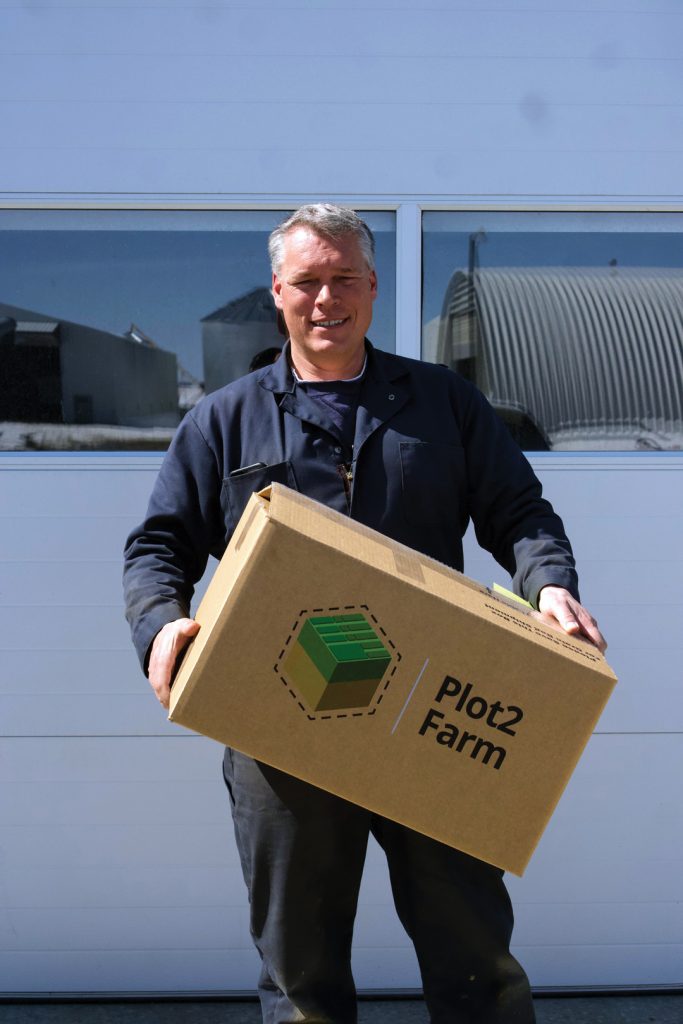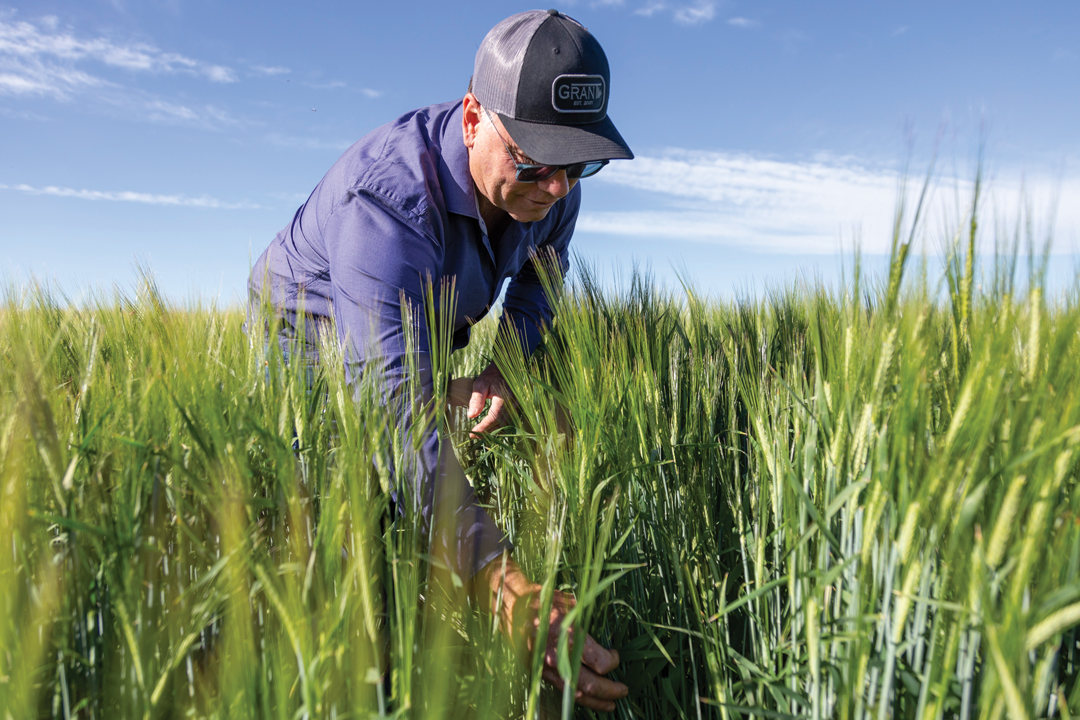ON-FARM AUDITIONS
BY IAN DOIG • LEAD PHOTO OF ROY NEWMAN BY NICOLE MURRAY PHOTOGRAPHY
Most farmers don’t conduct regular new variety trials on their own farms. Typically, farmers take a longterm approach. When the performance of a trusted variety sags, they may consult the Alberta Seed Guide and plant a few dozen acres, or even an entire field, of a newer variety listed within its pages.
The process is frequently informal, and a yield bump may seal the deal. “It depends what characteristic they’re looking for,” said Lara de Moissac, Alberta Grains agronomy programs specialist and Alberta Regional Variety Trial (RVT) co-ordinator. “If the old and new varieties yield the same, they may go with the one that stands up better, because it’s easier to harvest. If they contend with frost, maybe they go with one that matures earlier.”
Unfortunately, a new variety may get just one shot to prove itself. Most farmers do not trial varieties over successive years. In support of those Seed Guide varieties, this is where the RVT program shines. In a nutshell, varieties are grown in multiple locations across the Prairies with identical but basic agronomics. This reveals how a variety may perform in each region.
With this geographic knowledge, a farmer can zero in on varieties that may best suit their farm. This can be done informally or in controlled trials with the help of an agronomist.
The Alberta Grains Plot2Farm program, now going into its fifth year, can assist with such variety comparison trials. de Moissac suggests an interested farmer can apply to the program with a two-year trial proposal.
Whatever the method, de Moissac said on-farm trials are valuable. “It’s about finding the variety with the genetics that perform best in their environment with their management and closing that yield gap, where a variety may perform better in your area than the one you now grow.”
Scott Gillespie is an agronomist who works with irrigated farms in the area around Taber, Vauxhall and Scandia. With a focus on organic and regenerative agriculture, he regularly assists with the trial process for new field practices and varieties. Much of his time during the growing season is spent scouting potatoes. Though he also works with sugar beets, dry beans and seed canola, cereals are grown on about half the acres he oversees. Also economically valuable crops, cereals make good rotational sense between high-value broadleaf crops.
Though some of his clients conduct replicated variety trials, it’s usually an informal process. He advises it’s simple to fill one compartment of a semi load when picking up a grain shipment. This will provide enough seed for a few hundred acres, which are easiest to sow at the start or end a field. With the variety line marked, he can track the variety, and even without, he can locate it by satellite or scouting.
The needs of Gillespie’s clients naturally relate to irrigation. Improved yield and disease resistance are always important, but standability is the most sought-after trait. Lodging is a big risk, especially with barley. The crop receives plenty of nitrogen and lots of water even up to the end stage when irrigation tends to give the plant an extra push downward. A desirable cereal either does not require a PGR or responds well to a PGR treatment.
The process should start with research, said Gillespie. Look at RVT results, attend local field days and seek out neighbours who have tried new varieties. If you prefer an informal approach, sow the varieties in the same field to ensure fair comparison and take thorough notes, he added. He does encourage clients to set up replicated trials for greater detail, as the process is relatively easy. “Even if you like the varieties you have, trying some new ones each year lets you see how they do before you have to make a switch,” he said. Trialling over multiple seasons is a good idea, he said, but noted, varieties cycle in and out of the market roughly every five years, which may limit the number of try-out seasons that are practical. “You don’t want to be always seeding the same variety every year, and then suddenly find out a variety is not available. Then you’re scrambling.”
Roy Newman is an Alberta Grains Region 2 delegate and farms barley, canola, peas and wheat near Blackie. Newman trials new varieties on his farm every two years, though he’d like to do so more often. Following the steps Gillespie recommends, he does his homework. He also regularly consults information sheets published by seed growers.
When his current varieties start to slip and agronomists and neighbours endorse new names, he takes heed. For instance, in part at the suggestion of his local maltster, this past season he trialled CDC Fraser. It was shorter with better standability and delivered a yield bump, so he adopted it over CDC Copeland.
In 2023, he carried out a formal variety trial with the Plot2Farm program. In two-acre wheat plots replicated six times, the trial pitted his thencurrent variety, CDC Go, against AAC Viewfield and AAC Hodge. Viewfield’s performance impressed him, as did the trial process. “It was good value, because there was a yield and a quality difference with Viewfield,” he said.
“It was between 5.5 and six per cent, which was enough for me to switch my varieties for good.” He noted, though, that a two- to five-bushel yield bump may not always be enough to convince a farmer to switch varieties. While Go had hit 100 bu/ac in the past, he believes Viewfield has the same potential. Hodge performed similarly to Go.
He looks for similar qualities in both wheat and barley varieties. “I wanted less plant material and the same yield in a shorter variety because we were having lodging problems.” Because his replicated wheat trials were productive, he will repeat the process in future, despite being cumbersome and time consuming. To launch the 20-acre project took most of a day and multiple vehicles and because he had just acquired a new seeder, this added complication. He admitted he subsequently used a simpler process in trialling peas and sowed adjacent 100-acre plots. Such large plots eliminate localized variations in soil quality that can skew the results of small-scale trials.
And his process has now evolved further with the use of a precision ag platform. “We’ve switched over to FieldView. We don’t have to isolate grain from the 60-acre plots we’re doing because the GPS does that for us. We won’t know where they’re at when we’re combining it, but they’ll show up in the data. It makes sense because the technology on our combines is better and now you don’t have to worry about a weigh cart.”
On-farm trials are a practice he hopes more people will adopt. “It’s important that everybody does on-farm trials, because our area is different than guys 10 miles south of us. It can be a lot of work, but if everybody does their due diligence and shares that information, it makes our neighbours better, it makes the whole industry better and we’ll have better varieties to sell to the world.”

Gordon Ellis is an Alberta Grains Region 2 delegate and farms wheat, barley, canola and yellow peas near Olds. He has long trialled new varieties as they have been released. Typically, he seeds a strip of the new variety. It’s harvested and weighed in comparison to an identical combine pass on the current variety. Though not replicated, the process makes for a good comparison, he said.
He had grown AC Foremost for several years, as it is a sensible choice for the higher rainfall conditions of the Highway 2 corridor. Formerly in the CPS red class, it was redesignated a CNHR variety in 2018. This affected crop insurance and less elevators now purchase it. “But it’s still well suited to the area east of olds,” he said. Like Newman, Ellis participated in a Plot2Farm replicated variety trial in 2020. With a degree in agriculture from the University of Lethbridge and having worked for a major ag company on small-plot trials, he was familiar with the process and emphasizes the value of replication given soil variability. He chose to try AAC Goodwin as a potential spring wheat replacement for Foremost. “There was a 20-bushel difference in the two varieties, not in favour of Goodwin, so I don’t need to grow that one again,” he said with a laugh.
As he continues to look for a replacement to get back into the CPS red class, he continues trials of interesting new varieties. He has found CDC Rain and AAC Penhold both didn’t quite match the yield of Foremost.
For someone who has not done such trials, it may be a bit daunting, he said. But he encourages others to try the process because you can trust the data. “There’s scientific validity in replication that makes it worth doing. The biggest thing about doing on-farm research is proving the results to yourself under your own management, with your own equipment, on your own farm.”
Visit the Plot2Farm page at albertagrains.com to apply and download a research guide or contact jboychyn@albertagrains.com to inquire about the program.







Comments